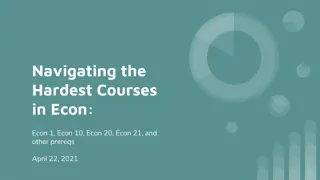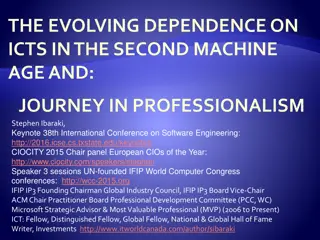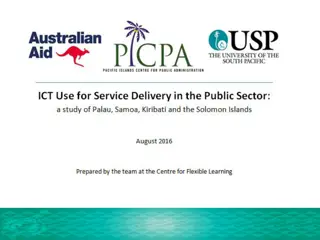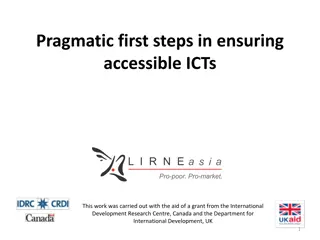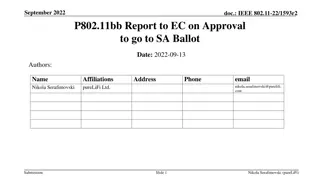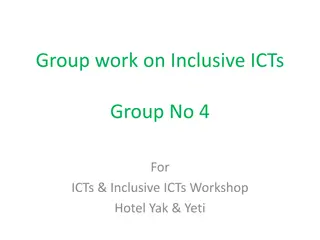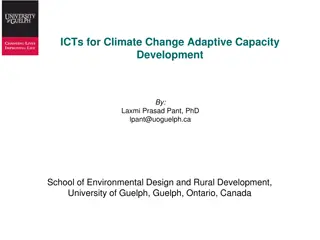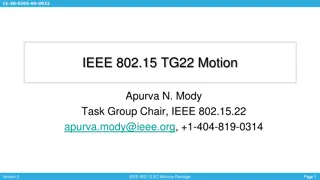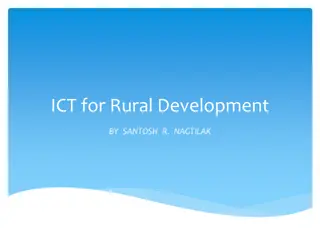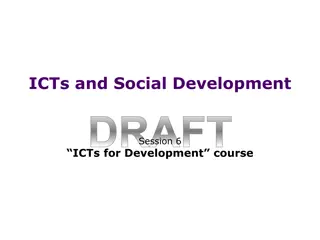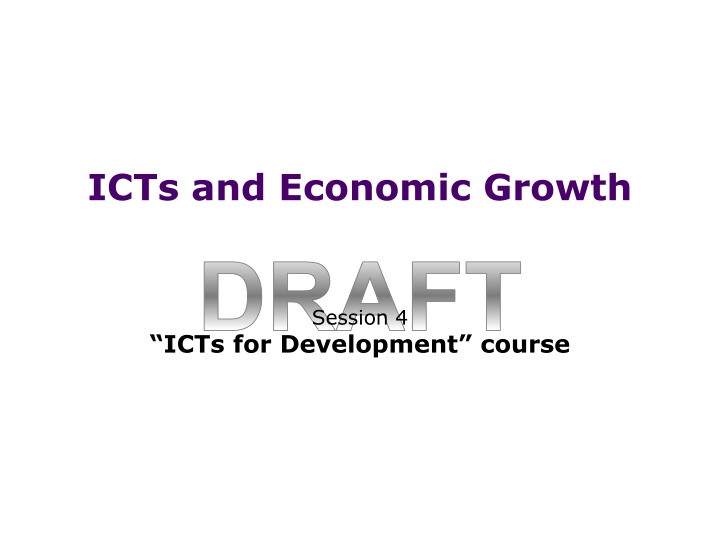
Exploring ICTs and Economic Growth Through Development Strategies
Discover the crucial role of Information and Communication Technologies (ICTs) in driving economic growth and development. From understanding the impact of ICT on life expectancy and income to exploring various routes to economic growth, value chains, enterprise processes, and levels of ICT-enabled change, this content provides valuable insights. Learn how ICTs can lead to savings and efficiency for farmers, entrepreneurs, and micro-entrepreneurs in developing countries. Delve into the transformative power of ICTs in structuring, reorganizing, and digitizing operations for enhanced agency.
Download Presentation

Please find below an Image/Link to download the presentation.
The content on the website is provided AS IS for your information and personal use only. It may not be sold, licensed, or shared on other websites without obtaining consent from the author. If you encounter any issues during the download, it is possible that the publisher has removed the file from their server.
You are allowed to download the files provided on this website for personal or commercial use, subject to the condition that they are used lawfully. All files are the property of their respective owners.
The content on the website is provided AS IS for your information and personal use only. It may not be sold, licensed, or shared on other websites without obtaining consent from the author.
E N D
Presentation Transcript
ICTs and Economic Growth DRAFT ICTs for Development course Session 4
Life Expectancy vs. Income 90 85 80 75 Life Expectancy (years, 2014) DRAFT 70 R = 0.6667 65 60 55 50 45 40 100 1000 Gross National Income per capita (US$, 2015) 10000 100000 Richard Heeks, GDI, University of Manchester, UK Data source: WB 2017b
Routes to Economic Growth a) b) c) Economy Efficiency Profitability Inputs Process Outputs DRAFT d) Upgrading e) Restructuring (New Sector) Inputs New Process Outputs Inputs Process Outputs Value Added Value Added Value Value Richard Heeks, GDI, University of Manchester, UK
Typical Enterprise Value Chain Administration DRAFT Purchasing Operations Sales Richard Heeks, GDI, University of Manchester, UK Adapted from Laudon & Laudon 2016; itself developed from Porter 1985
CIPSODAR Model of Key Enterprise Processes Developing Countries Information Uncertainty of Knowledge Asymmetry of Information Absence of Information DRAFT (output) Learning Cost of Information Poor Quality of Information Data (capture, input, process, store) Information Decision Action -Purchasing -Operations -Sales -Admin. Results (economic growth) Richard Heeks, GDI, University of Manchester, UK
Levels of ICT-Enabled Change Transform Structure System Processes Reorganise DRAFT Content Technology Improve Agency (Motivation and Capacity) Digitise Richard Heeks, GDI, University of Manchester, UK
Journey Substitution Savings Farmers and rural entrepreneurs in Niger would, an average, require a three-hour round trip to the nearest main market. Substituting that with a phone call in order to gather information would save around 300 CFA (US$0.5) (Aker & Mbiti 2010). Smallholder farmers in Malawi were estimated to save an average of US$1 per purchase/sales transaction as a result of using ICTs (in this case, an online trading platform, with savings calculated in terms of both time and transport) (Katengeza et al 2014). DRAFT Micro-entrepreneurs in Nigeria typically spent up to N250 (US$1.25) on a phone call but saved N1,000 (US$5) on the typical cost of a taxi journey; a net saving of US$3.75 (Jagun et al 2008). Richard Heeks, GDI, University of Manchester, UK
Impact of Price Information Systems 7-10% increase in price for maize and groundnuts (Courtois & Subervie 2015). Design-Reality Gaps -Trust - Middlemen Broader Impact - Production mix DRAFT No difference in price for ICT-using and non-ICT using farmers (Fafchamps & Minten 2012). ? Impact of price information on income and sales of potato farmers was statistically indistinguishable from zero (Mitra et al 2015). Richard Heeks, GDI, University of Manchester, UK
Enterprise Reorganisation DRAFT Image sources: http://www.nationalgeographic.com/foodfeatures/land-grab/; http://www.heidiwoodman.com/goldfever/; http://www.heartforuganda.com/microfinance/; https://www.wbginvestmentclimate.org/advisory-services/regulatory-simplification/trade- logistics/learning-from-developing-country-experiences-to-implement-successful-agri-trade- Richard Heeks, GDI, University of Manchester, UK reforms.cfm
Reflections on ICTs and Micro- Economic Growth - Limited Change DRAFT - Drivers to Change - Risk/Reward Ladder Richard Heeks, GDI, University of Manchester, UK
Impact of ICT on Price Dispersion Variation in fish prices across different markets in South Kerala fell from 65% to 15% (Jensen 2007). Price variations across grain markets in Niger fell by 10% with introduction of mobile phones (Aker 2010). DRAFT Use of the Reuters Mobile Light price information app led price dispersion of crops across different rural markets in India to fall by 12% compared to just presence of mobiles alone (Parker et al 2015). Richard Heeks, GDI, University of Manchester, UK
Mobiles and Cloth-Weaving Supply Chain INTEGRATED STRUCTURE Concentric rings of absolute geographic space Indirect link via third-party No access to mobile telephony communication accomplished by physical movement between locations Thread Dealer Access to mobile telephony certain types of information communicated Weaver DRAFT Master- Weaver mediary by phone. Weaver Sub- Weaver Sub- Weaver Inter- mediary NON- INTEGRATED STRUCTURE Sub- Weaver Sub- Weaver Buyers Inter- Weaver Weaver Physical move following call Weaver/ Co-ord. OUTSOURCED STRUCTURE Thread Dealer COORDINATED STRUCTURE Richard Heeks, GDI, University of Manchester, UK Source: Jagun et al 2008
Internet Usage vs. Gross National Income 100 90 80 Internet Users as % of Population (2015) 70 DRAFT 60 R = 0.8267 50 40 30 20 10 0 100 1000 Gross National Income per capita (US$, 2015) 10000 100000 Richard Heeks, GDI, University of Manchester, UK Data source: WB 2017b
ICTs as a Cause of Economic Growth 10 more mobile phones per 100 people would increase GDP per capita growth by up to 0.6 percentage points (Deloitte 2012:4). DRAFT an increase in the broadband penetration rate by 10 percentage points raised annual growth in per capita GDP by 0.9-1.5 percentage points (Czernich et al 2011:530). Richard Heeks, GDI, University of Manchester, UK
Where is ICTs Economic Impact Greater? DRAFT Richard Heeks, GDI, University of Manchester, UK Image source: http://www.campusministrytoolbox.org/journals/gobilizing-a-new-missions- paradigm/
Extensive Use of ICTs ICT Consumption/Application Higher Productivity Than Other Sectors Millions Employed DRAFT Content c.3% of GDP (mid- income) c.1.5% of GDP (low- income) Double Digit Annual Growth Services Retail Goods Software Infra- structure Richard Heeks, GDI, University of Manchester, UK Source: Heeks 2008e



